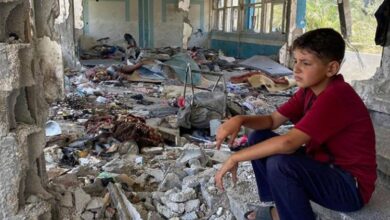Gaza’s Healthcare Crisis: Current Challenges and Future Prospects for Survival
The Israeli occupation continues its ongoing bombardment of Gaza, blatantly disregarding international laws that prohibit collective punishment. According to Article 33 of the Geneva Convention, “No collective penalty shall be inflicted on a group of people for an offense committed by another, whether it concerns prisoners of war or other individuals.”
This relentless assault has led to the collapse of Gaza’s healthcare system on all fronts, from the bombing of hospitals and severe shortages in medical supplies to the destruction of infrastructure and the spread of diseases due to uninhabitable living conditions. The World Health Organization (WHO) has issued reports from its emergency medical team, revealing that 25% of all injured individuals, approximately 22,500 people, are likely to require acute and ongoing rehabilitation, with limb injuries being the most common, affecting around 15,000 people. As these numbers continue to rise and the health crisis continues to spread , we must ask: what is the future of Gaza’s healthcare system?
The health situation in Gaza today: present challenges
Since the beginning of the current conflict, the Israeli occupation has targeted hospitals in the Gaza Strip in a series of attacks, leading to a humanitarian crisis in healthcare. The destruction of Al-Shifa Hospital on November 3 was a pivotal event, signaling a broader trend. Recent satellite imagery reveals that a total of 24 hospitals have been destroyed, including 6 in northern Gaza, 10 in Gaza City, 7 in Khan Younis, and one in the central region. This extensive damage has severely impacted the remaining healthcare facilities, which are overwhelmed by a surge in injuries and a critical shortage of medical services. Can we imagine what the consequences of this destruction will be?

1. Collapse of Health Infrastructure
This destruction encompasses not only buildings but also extends to critical medical equipment and devices. The ongoing blockade has made it increasingly difficult to import the necessary construction materials needed to rebuild these healthcare facilities. As a result, the few remaining hospitals are forced to rely on outdated or insufficient equipment.
According to the United Nations Relief and Works Agency for Palestine Refugees (UNRWA), a staggering 84% of health facilities in Gaza have been affected by attacks since the onset of the war on October 7.
2. Shortage of Medical Resources
The blockade on Gaza has made it difficult to bring in essential medical supplies, such as necessary medicines and medical equipment. As a result, doctors often have to use outdated or inadequate tools, which negatively affects the quality of healthcare available to people. This shortage of medical resources worsens the ongoing humanitarian crisis in Gaza and creates serious challenges for patient care.
as reported by the United Nations Office for the Coordination of Humanitarian Affairs (OCHA), between 1 and 15 September 2024, an average of only 67 humanitarian aid trucks entered the Gaza Strip each day. This figure is significantly below the pre-crisis average of 500 trucks per working day, underscoring the critical shortages of essential supplies and the ongoing humanitarian emergency faced by the people of Gaza.
3. Outbreak of Diseases
In a statement released by the World Health Organization (WHO), the most reported cases in the Gaza Strip include measles and mumps, along with over 600,000 cases of upper respiratory infections. The statement also highlighted numerous cases of meningitis, hepatitis, skin rashes, scabies, lice infestations, and chickenpox
The Most Common Diseases in Gaza
1. The polio virus
Polio is a highly infectious disease caused by a virus that invades the nervous system, leading to total paralysis within hours. The virus spreads primarily through person-to-person contact via the fecal-oral route or, less commonly, through contaminated water or food. It multiplies in the intestines, making areas with poor sanitation especially vulnerable. According to the (WHO), children in Gaza under the age of five, particularly infants under two who have not been vaccinated, are at high risk of contracting polio
In Addition The Palestinian Ministry of Health recently announced the discovery of the CVPV2 polio virus in wastewater in the Khan Yunis and Central governorates. This alarming finding poses a severe public health threat not only to Gaza but also to neighboring countries. Immediate action is needed to contain the virus and prevent its spread.
2. Malnutrition
Researchers in a report prepared by academics from the London School of Hygiene and Tropical Medicine predict that The ongoing war in Gaza has precipitated a nutritional emergency for children.
Additionally, the conflict’s disruption of breastfeeding due to stress and privacy violations exacerbates neonatal and infant health risks.
However, acute malnutrition combines into a projected high risk of excess deaths from a variety of infectious diseases.

3. Hepatitis B
Hepatitis B is primarily transmitted through contact with bodily fluids, including blood and semen, often spread from mother to child during birth or through the use of contaminated needles. Gaza is currently facing a public health crisis, exacerbated by the collapse of its waste management system. UN agencies recently reported that Gaza’s inability to access major landfills has led to widespread exposure to disease-causing waste, worsening health conditions.
Haaretz reports that over 100,000 cases of viral Hepatitis B have been recorded in Gaza, a dramatic rise from just 85 cases last year. This staggering increase, over 1,100 times higher than the previous year, highlights the deteriorating sanitary conditions. Additionally, unhealthy practices, such as washing and reusing sanitary pads due to resource shortages, have further contributed to the spike in cases. The UN Relief and Works Agency for Palestine Refugees (UNRWA) has also reported a rise in cases of Hepatitis A, another viral infection spread through contaminated food or water, further complicating the health crisis.
4. Respiratory Diseases
Respiratory diseases in Gaza have been on the rise due to several compounding factors, including air pollution, overcrowded living conditions, and the ongoing humanitarian crisis. The region’s environmental and health infrastructure challenges are contributing to a severe public health problem, with respiratory illnesses being some of the most common afflictions , there are more than 223,000 cases of acute respiratory infections
Gaza Media Office reported hundreds of cases in the Gaza Strip afflicted with respiratory illnesses were recorded in the hospitals due to residents resorting to igniting fires to cook food amid the shortage of cooking gas.
The Future of Health and Disease in Gaza
The future of health in Gaza remains uncertain and grim under the current circumstances Without substantial international intervention to rebuild healthcare systems and improve living conditions, the people of Gaza face an increasingly dangerous public health landscape. Restoring access to clean water, medicines, and functioning hospitals will be crucial to prevent further outbreaks and improve overall health outcomes. Addressing these issues is essential to mitigate the long-term health risks posed by the ongoing conflict.




